IKEA's Strengths and Weaknesses: An Analysis for BUSM4590 Report
VerifiedAdded on 2023/06/08
|12
|3036
|345
Report
AI Summary
This report examines IKEA's strengths and weaknesses through the lens of the Symbolic Frame from Bolman and Deal's Four Frame Model. It analyzes IKEA's sustainability efforts and organizational culture using theories from William Ouchi, Peter Senge, and Edgar Schein. The report explores how IKEA maintains a positive image and eco-friendly practices. It delves into Theory Z, shared vision, team learning, systems thinking, and organizational culture levels to understand IKEA's approach to employee well-being, environmental responsibility, and customer satisfaction. The analysis highlights IKEA's efforts to create a positive impact on people and the planet, emphasizing its commitment to ethical and sustainable business practices.
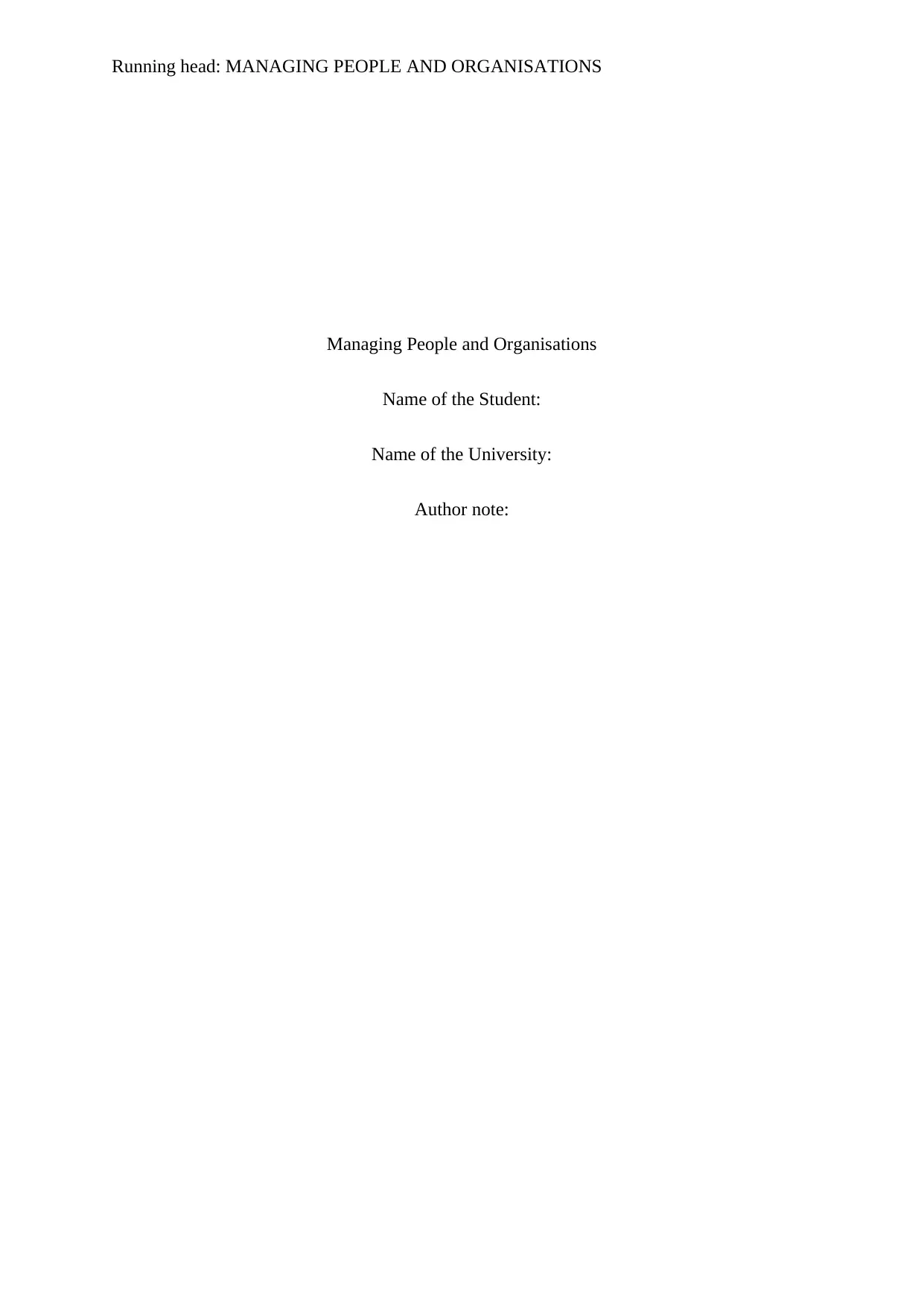
Running head: MANAGING PEOPLE AND ORGANISATIONS
Managing People and Organisations
Name of the Student:
Name of the University:
Author note:
Managing People and Organisations
Name of the Student:
Name of the University:
Author note:
Paraphrase This Document
Need a fresh take? Get an instant paraphrase of this document with our AI Paraphraser
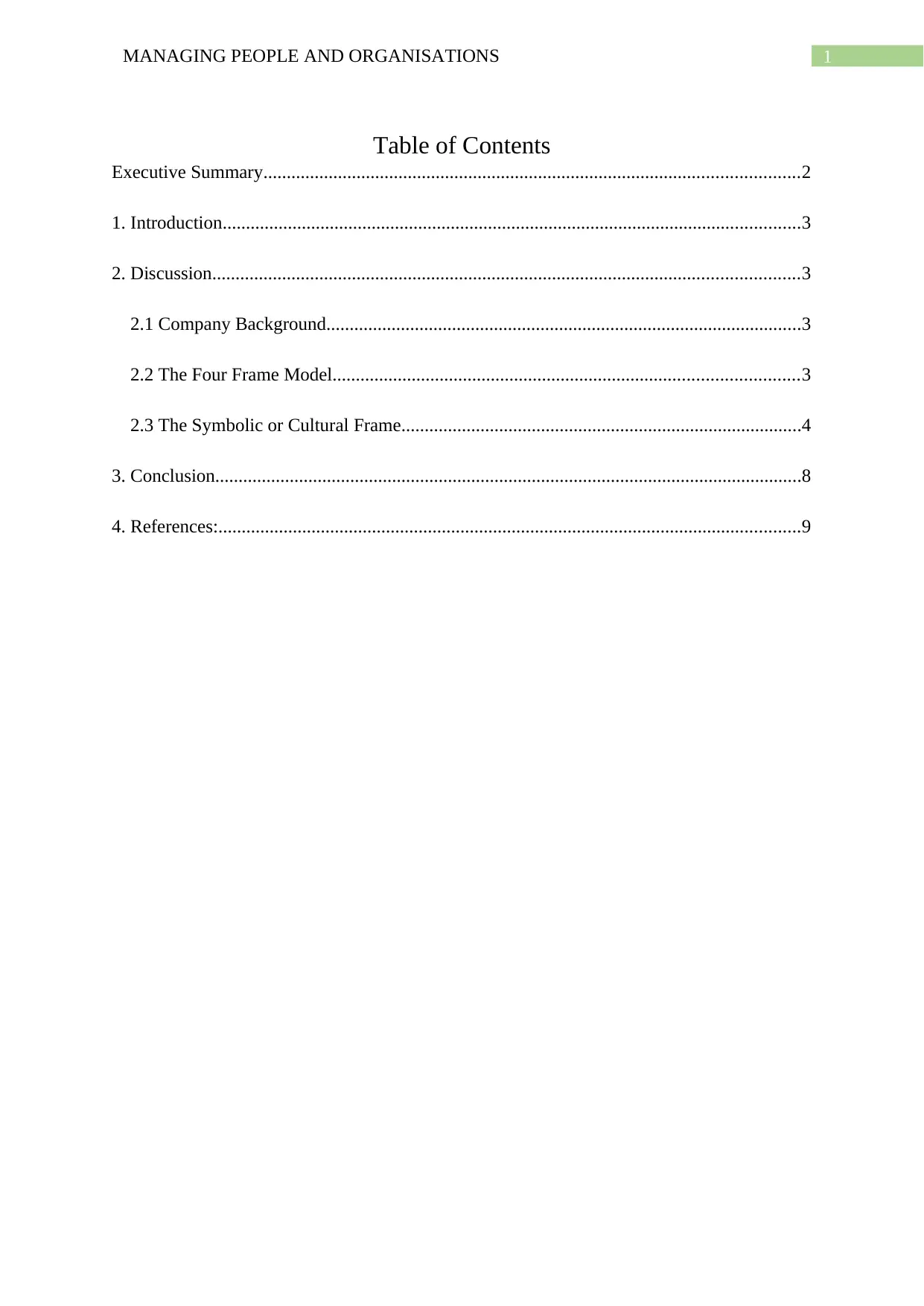
1MANAGING PEOPLE AND ORGANISATIONS
Table of Contents
Executive Summary...................................................................................................................2
1. Introduction............................................................................................................................3
2. Discussion..............................................................................................................................3
2.1 Company Background......................................................................................................3
2.2 The Four Frame Model....................................................................................................3
2.3 The Symbolic or Cultural Frame......................................................................................4
3. Conclusion..............................................................................................................................8
4. References:.............................................................................................................................9
Table of Contents
Executive Summary...................................................................................................................2
1. Introduction............................................................................................................................3
2. Discussion..............................................................................................................................3
2.1 Company Background......................................................................................................3
2.2 The Four Frame Model....................................................................................................3
2.3 The Symbolic or Cultural Frame......................................................................................4
3. Conclusion..............................................................................................................................8
4. References:.............................................................................................................................9
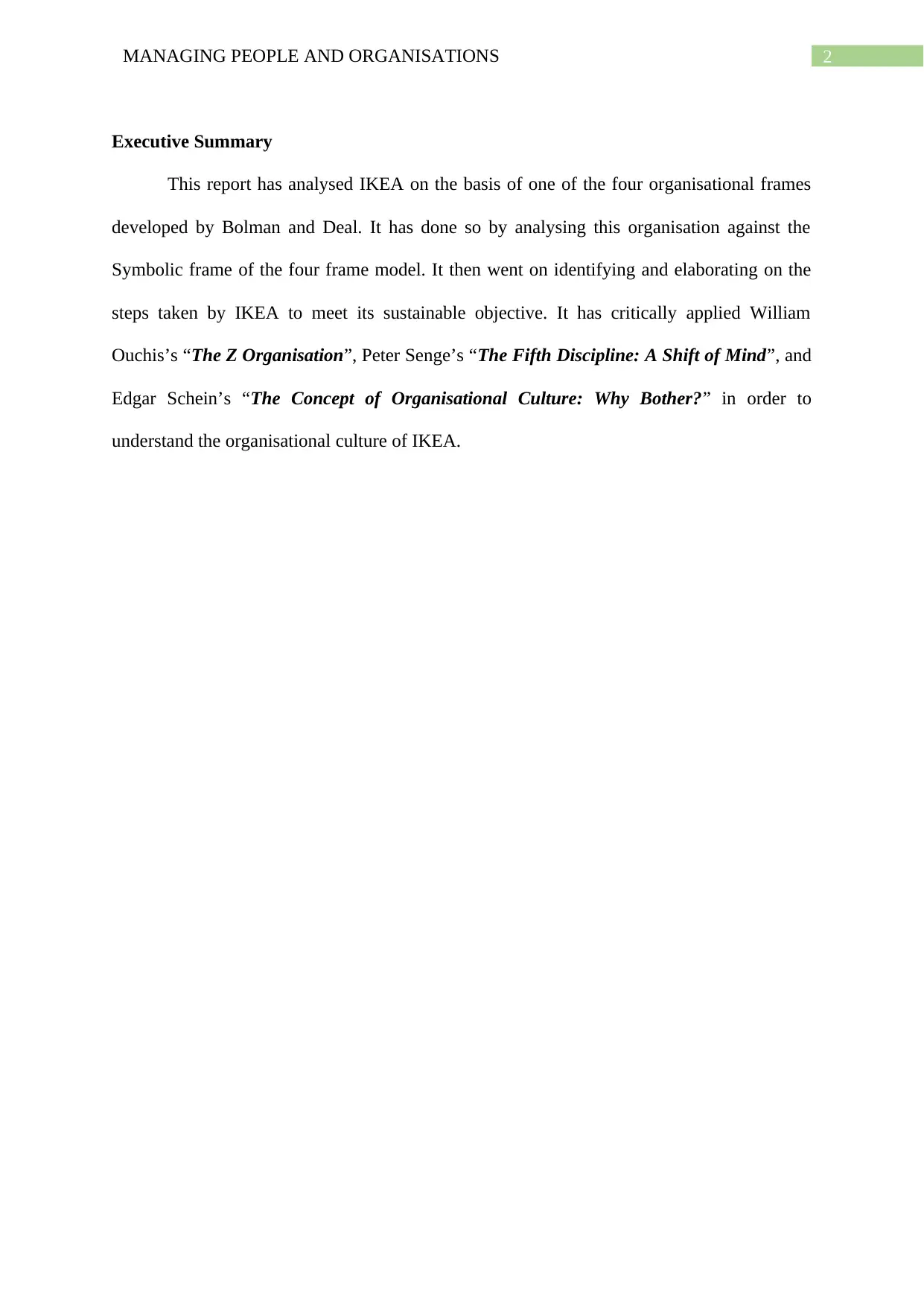
2MANAGING PEOPLE AND ORGANISATIONS
Executive Summary
This report has analysed IKEA on the basis of one of the four organisational frames
developed by Bolman and Deal. It has done so by analysing this organisation against the
Symbolic frame of the four frame model. It then went on identifying and elaborating on the
steps taken by IKEA to meet its sustainable objective. It has critically applied William
Ouchis’s “The Z Organisation”, Peter Senge’s “The Fifth Discipline: A Shift of Mind”, and
Edgar Schein’s “The Concept of Organisational Culture: Why Bother?” in order to
understand the organisational culture of IKEA.
Executive Summary
This report has analysed IKEA on the basis of one of the four organisational frames
developed by Bolman and Deal. It has done so by analysing this organisation against the
Symbolic frame of the four frame model. It then went on identifying and elaborating on the
steps taken by IKEA to meet its sustainable objective. It has critically applied William
Ouchis’s “The Z Organisation”, Peter Senge’s “The Fifth Discipline: A Shift of Mind”, and
Edgar Schein’s “The Concept of Organisational Culture: Why Bother?” in order to
understand the organisational culture of IKEA.
⊘ This is a preview!⊘
Do you want full access?
Subscribe today to unlock all pages.

Trusted by 1+ million students worldwide

3MANAGING PEOPLE AND ORGANISATIONS
1. Introduction
Organisations are some of the most complicated entities that are with huge number of
capabilities, objectives, motivations, personalities and limitations (Skelcher and Smith 2015).
It is very important to assess each and every aspects of an organisation in order to have a
good understanding of it. As the growing impact of global warming on the planet earth, most
of the companies has now begin to seek more ways for providing products and services. In
this report I shall be examining and evaluating the strengths and weaknesses of the
organisation in which I work- IKEA on the basis of one of the elements of the Four Frame
Model, especially the Symbolic Frame. It has critically analysed different theories in order to
provide a clear understanding of its organisational culture. Using these theories, this report
has successfully provided a relevant and in-depth understanding of how this company
prolongs its organisations in today’s business dynamic world.
2. Discussion
2.1 Company Background
IKEA was founded by Ingvar Kamprad, a Swedish Entrepreneur in the year 1943
(Vahlne and Jonsson 2017). It is one of the well-known multinational furniture retailing
company which sells the ready to assemble types of furniture as well as home accessories and
appliances. At present IKEA is been operating in more than 41 different countries all around
the work including Australia, North America, Europe, Southeast Asia and Middle East with
over 30 franchised units and 300 stores (Garvey 2017). It sells inexpensive furniture all
around the world and they are of Scandinavian design.
2.2 The Four Frame Model
1. Introduction
Organisations are some of the most complicated entities that are with huge number of
capabilities, objectives, motivations, personalities and limitations (Skelcher and Smith 2015).
It is very important to assess each and every aspects of an organisation in order to have a
good understanding of it. As the growing impact of global warming on the planet earth, most
of the companies has now begin to seek more ways for providing products and services. In
this report I shall be examining and evaluating the strengths and weaknesses of the
organisation in which I work- IKEA on the basis of one of the elements of the Four Frame
Model, especially the Symbolic Frame. It has critically analysed different theories in order to
provide a clear understanding of its organisational culture. Using these theories, this report
has successfully provided a relevant and in-depth understanding of how this company
prolongs its organisations in today’s business dynamic world.
2. Discussion
2.1 Company Background
IKEA was founded by Ingvar Kamprad, a Swedish Entrepreneur in the year 1943
(Vahlne and Jonsson 2017). It is one of the well-known multinational furniture retailing
company which sells the ready to assemble types of furniture as well as home accessories and
appliances. At present IKEA is been operating in more than 41 different countries all around
the work including Australia, North America, Europe, Southeast Asia and Middle East with
over 30 franchised units and 300 stores (Garvey 2017). It sells inexpensive furniture all
around the world and they are of Scandinavian design.
2.2 The Four Frame Model
Paraphrase This Document
Need a fresh take? Get an instant paraphrase of this document with our AI Paraphraser
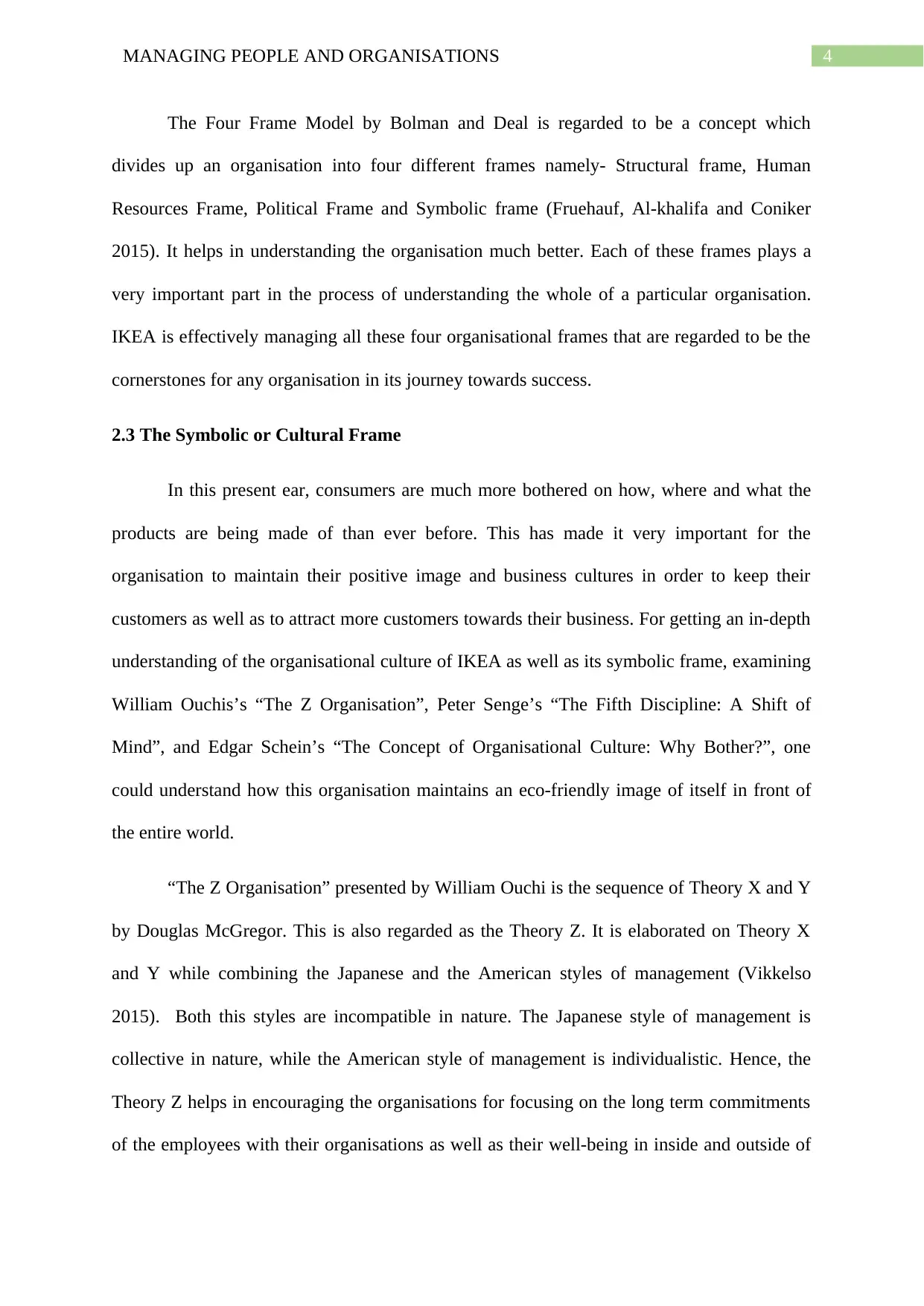
4MANAGING PEOPLE AND ORGANISATIONS
The Four Frame Model by Bolman and Deal is regarded to be a concept which
divides up an organisation into four different frames namely- Structural frame, Human
Resources Frame, Political Frame and Symbolic frame (Fruehauf, Al-khalifa and Coniker
2015). It helps in understanding the organisation much better. Each of these frames plays a
very important part in the process of understanding the whole of a particular organisation.
IKEA is effectively managing all these four organisational frames that are regarded to be the
cornerstones for any organisation in its journey towards success.
2.3 The Symbolic or Cultural Frame
In this present ear, consumers are much more bothered on how, where and what the
products are being made of than ever before. This has made it very important for the
organisation to maintain their positive image and business cultures in order to keep their
customers as well as to attract more customers towards their business. For getting an in-depth
understanding of the organisational culture of IKEA as well as its symbolic frame, examining
William Ouchis’s “The Z Organisation”, Peter Senge’s “The Fifth Discipline: A Shift of
Mind”, and Edgar Schein’s “The Concept of Organisational Culture: Why Bother?”, one
could understand how this organisation maintains an eco-friendly image of itself in front of
the entire world.
“The Z Organisation” presented by William Ouchi is the sequence of Theory X and Y
by Douglas McGregor. This is also regarded as the Theory Z. It is elaborated on Theory X
and Y while combining the Japanese and the American styles of management (Vikkelso
2015). Both this styles are incompatible in nature. The Japanese style of management is
collective in nature, while the American style of management is individualistic. Hence, the
Theory Z helps in encouraging the organisations for focusing on the long term commitments
of the employees with their organisations as well as their well-being in inside and outside of
The Four Frame Model by Bolman and Deal is regarded to be a concept which
divides up an organisation into four different frames namely- Structural frame, Human
Resources Frame, Political Frame and Symbolic frame (Fruehauf, Al-khalifa and Coniker
2015). It helps in understanding the organisation much better. Each of these frames plays a
very important part in the process of understanding the whole of a particular organisation.
IKEA is effectively managing all these four organisational frames that are regarded to be the
cornerstones for any organisation in its journey towards success.
2.3 The Symbolic or Cultural Frame
In this present ear, consumers are much more bothered on how, where and what the
products are being made of than ever before. This has made it very important for the
organisation to maintain their positive image and business cultures in order to keep their
customers as well as to attract more customers towards their business. For getting an in-depth
understanding of the organisational culture of IKEA as well as its symbolic frame, examining
William Ouchis’s “The Z Organisation”, Peter Senge’s “The Fifth Discipline: A Shift of
Mind”, and Edgar Schein’s “The Concept of Organisational Culture: Why Bother?”, one
could understand how this organisation maintains an eco-friendly image of itself in front of
the entire world.
“The Z Organisation” presented by William Ouchi is the sequence of Theory X and Y
by Douglas McGregor. This is also regarded as the Theory Z. It is elaborated on Theory X
and Y while combining the Japanese and the American styles of management (Vikkelso
2015). Both this styles are incompatible in nature. The Japanese style of management is
collective in nature, while the American style of management is individualistic. Hence, the
Theory Z helps in encouraging the organisations for focusing on the long term commitments
of the employees with their organisations as well as their well-being in inside and outside of

5MANAGING PEOPLE AND ORGANISATIONS
the organisations. The very first assumptions of “Theory Z” is that individuals need to sense
the support of the job security as well as facilitate for developing their potentials within the
company (Dederichs 2018). Like, for example, IKEA Australia offers its employees
education assistance who seeks for the managerial roles for them in the organisation (Hahn
and Kim 2016). Through this, it is educating the workforce as well as helping them in
discovering their own skills, talents and knowledge. Furthermore, the second assumption of
“Theory Z” is that people cherish their family life, organisation and culture all at the same
level and they give value to material gains. After understanding this assumption, IKEA has
offered its employees with families with paid paternity and maternity leave. Due to this IKEA
is widely considered to be one among the top 100 organisations for the working mothers as
per the IKEA National Press Releases of 2007 (Morsing and Roepstorff 2015). Also, the last
assumption of “Theory Z” is that individuals would develop a sense of dedication along with
self-discipline while discovering what the organisations means to them. Due to this reason,
IKEA has launched its project called “People and Planet” in its organisation in order to
ensure that its employees could feel that they are working for a company which care about
the environment and their society. Therefore, every year, the employees of IKEA along with
its consumers join the force together for working in the campaigns which help in raising
money for the UNHCR (the refugee agency of UN), Save the Children and UNICEF. In this
way, the consumers and the employees of IKEA are sensing the feeling of belonging to the
organisation as they feel that their contribution are going for some really good causes.
Peter Senge’s “The Fifth Discipline: A Shift of Mind” has explained the important
elements in the learning organisations such as mental models, personal mastery, team
learning, systems thinking and building shared vision. This section would correlate building
of shared vision, system thinking and team learning to the IKEA. Building shared vision
refers to the blending of the aspirations of the employees with the goals of the company. The
the organisations. The very first assumptions of “Theory Z” is that individuals need to sense
the support of the job security as well as facilitate for developing their potentials within the
company (Dederichs 2018). Like, for example, IKEA Australia offers its employees
education assistance who seeks for the managerial roles for them in the organisation (Hahn
and Kim 2016). Through this, it is educating the workforce as well as helping them in
discovering their own skills, talents and knowledge. Furthermore, the second assumption of
“Theory Z” is that people cherish their family life, organisation and culture all at the same
level and they give value to material gains. After understanding this assumption, IKEA has
offered its employees with families with paid paternity and maternity leave. Due to this IKEA
is widely considered to be one among the top 100 organisations for the working mothers as
per the IKEA National Press Releases of 2007 (Morsing and Roepstorff 2015). Also, the last
assumption of “Theory Z” is that individuals would develop a sense of dedication along with
self-discipline while discovering what the organisations means to them. Due to this reason,
IKEA has launched its project called “People and Planet” in its organisation in order to
ensure that its employees could feel that they are working for a company which care about
the environment and their society. Therefore, every year, the employees of IKEA along with
its consumers join the force together for working in the campaigns which help in raising
money for the UNHCR (the refugee agency of UN), Save the Children and UNICEF. In this
way, the consumers and the employees of IKEA are sensing the feeling of belonging to the
organisation as they feel that their contribution are going for some really good causes.
Peter Senge’s “The Fifth Discipline: A Shift of Mind” has explained the important
elements in the learning organisations such as mental models, personal mastery, team
learning, systems thinking and building shared vision. This section would correlate building
of shared vision, system thinking and team learning to the IKEA. Building shared vision
refers to the blending of the aspirations of the employees with the goals of the company. The
⊘ This is a preview!⊘
Do you want full access?
Subscribe today to unlock all pages.

Trusted by 1+ million students worldwide
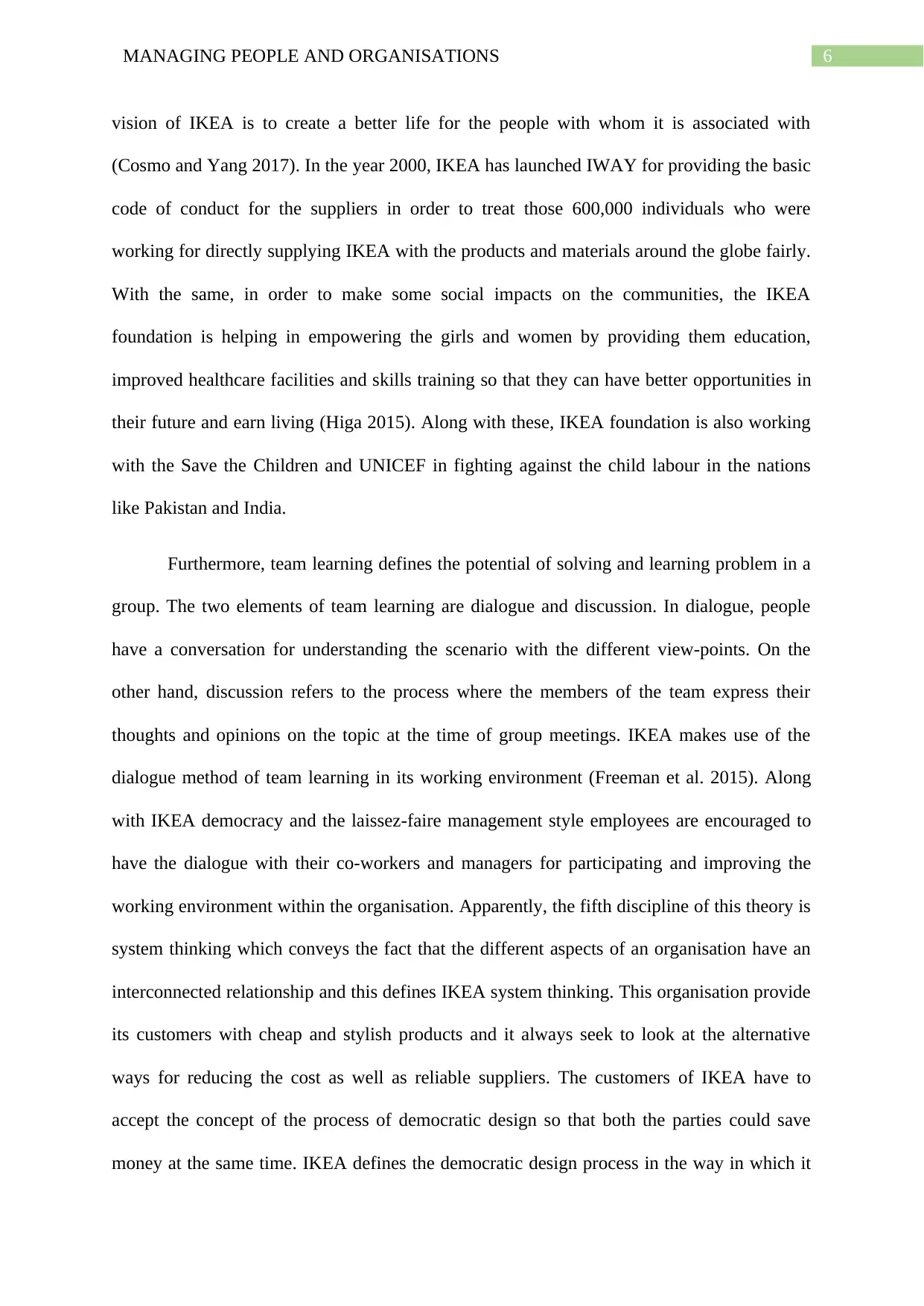
6MANAGING PEOPLE AND ORGANISATIONS
vision of IKEA is to create a better life for the people with whom it is associated with
(Cosmo and Yang 2017). In the year 2000, IKEA has launched IWAY for providing the basic
code of conduct for the suppliers in order to treat those 600,000 individuals who were
working for directly supplying IKEA with the products and materials around the globe fairly.
With the same, in order to make some social impacts on the communities, the IKEA
foundation is helping in empowering the girls and women by providing them education,
improved healthcare facilities and skills training so that they can have better opportunities in
their future and earn living (Higa 2015). Along with these, IKEA foundation is also working
with the Save the Children and UNICEF in fighting against the child labour in the nations
like Pakistan and India.
Furthermore, team learning defines the potential of solving and learning problem in a
group. The two elements of team learning are dialogue and discussion. In dialogue, people
have a conversation for understanding the scenario with the different view-points. On the
other hand, discussion refers to the process where the members of the team express their
thoughts and opinions on the topic at the time of group meetings. IKEA makes use of the
dialogue method of team learning in its working environment (Freeman et al. 2015). Along
with IKEA democracy and the laissez-faire management style employees are encouraged to
have the dialogue with their co-workers and managers for participating and improving the
working environment within the organisation. Apparently, the fifth discipline of this theory is
system thinking which conveys the fact that the different aspects of an organisation have an
interconnected relationship and this defines IKEA system thinking. This organisation provide
its customers with cheap and stylish products and it always seek to look at the alternative
ways for reducing the cost as well as reliable suppliers. The customers of IKEA have to
accept the concept of the process of democratic design so that both the parties could save
money at the same time. IKEA defines the democratic design process in the way in which it
vision of IKEA is to create a better life for the people with whom it is associated with
(Cosmo and Yang 2017). In the year 2000, IKEA has launched IWAY for providing the basic
code of conduct for the suppliers in order to treat those 600,000 individuals who were
working for directly supplying IKEA with the products and materials around the globe fairly.
With the same, in order to make some social impacts on the communities, the IKEA
foundation is helping in empowering the girls and women by providing them education,
improved healthcare facilities and skills training so that they can have better opportunities in
their future and earn living (Higa 2015). Along with these, IKEA foundation is also working
with the Save the Children and UNICEF in fighting against the child labour in the nations
like Pakistan and India.
Furthermore, team learning defines the potential of solving and learning problem in a
group. The two elements of team learning are dialogue and discussion. In dialogue, people
have a conversation for understanding the scenario with the different view-points. On the
other hand, discussion refers to the process where the members of the team express their
thoughts and opinions on the topic at the time of group meetings. IKEA makes use of the
dialogue method of team learning in its working environment (Freeman et al. 2015). Along
with IKEA democracy and the laissez-faire management style employees are encouraged to
have the dialogue with their co-workers and managers for participating and improving the
working environment within the organisation. Apparently, the fifth discipline of this theory is
system thinking which conveys the fact that the different aspects of an organisation have an
interconnected relationship and this defines IKEA system thinking. This organisation provide
its customers with cheap and stylish products and it always seek to look at the alternative
ways for reducing the cost as well as reliable suppliers. The customers of IKEA have to
accept the concept of the process of democratic design so that both the parties could save
money at the same time. IKEA defines the democratic design process in the way in which it
Paraphrase This Document
Need a fresh take? Get an instant paraphrase of this document with our AI Paraphraser
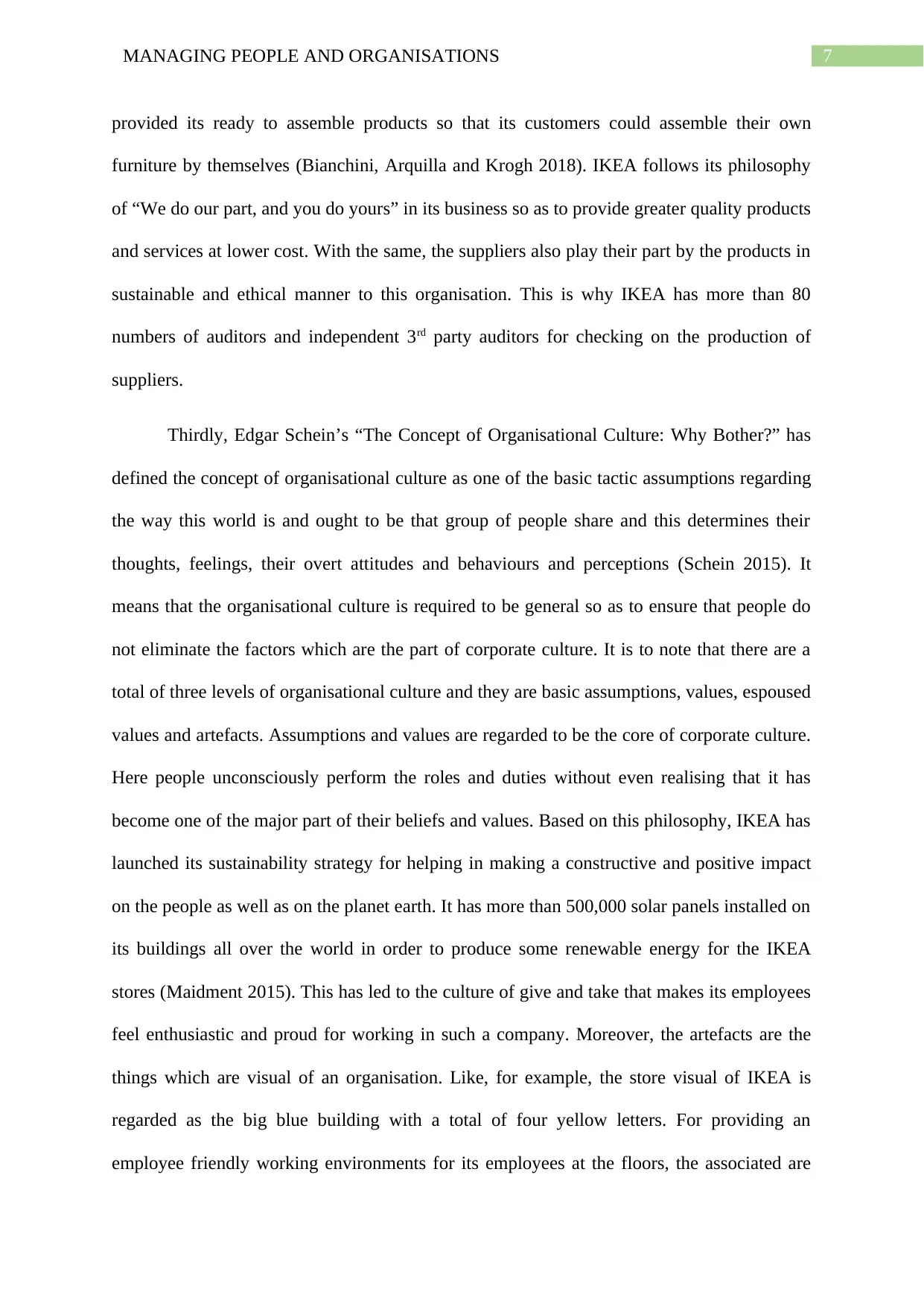
7MANAGING PEOPLE AND ORGANISATIONS
provided its ready to assemble products so that its customers could assemble their own
furniture by themselves (Bianchini, Arquilla and Krogh 2018). IKEA follows its philosophy
of “We do our part, and you do yours” in its business so as to provide greater quality products
and services at lower cost. With the same, the suppliers also play their part by the products in
sustainable and ethical manner to this organisation. This is why IKEA has more than 80
numbers of auditors and independent 3rd party auditors for checking on the production of
suppliers.
Thirdly, Edgar Schein’s “The Concept of Organisational Culture: Why Bother?” has
defined the concept of organisational culture as one of the basic tactic assumptions regarding
the way this world is and ought to be that group of people share and this determines their
thoughts, feelings, their overt attitudes and behaviours and perceptions (Schein 2015). It
means that the organisational culture is required to be general so as to ensure that people do
not eliminate the factors which are the part of corporate culture. It is to note that there are a
total of three levels of organisational culture and they are basic assumptions, values, espoused
values and artefacts. Assumptions and values are regarded to be the core of corporate culture.
Here people unconsciously perform the roles and duties without even realising that it has
become one of the major part of their beliefs and values. Based on this philosophy, IKEA has
launched its sustainability strategy for helping in making a constructive and positive impact
on the people as well as on the planet earth. It has more than 500,000 solar panels installed on
its buildings all over the world in order to produce some renewable energy for the IKEA
stores (Maidment 2015). This has led to the culture of give and take that makes its employees
feel enthusiastic and proud for working in such a company. Moreover, the artefacts are the
things which are visual of an organisation. Like, for example, the store visual of IKEA is
regarded as the big blue building with a total of four yellow letters. For providing an
employee friendly working environments for its employees at the floors, the associated are
provided its ready to assemble products so that its customers could assemble their own
furniture by themselves (Bianchini, Arquilla and Krogh 2018). IKEA follows its philosophy
of “We do our part, and you do yours” in its business so as to provide greater quality products
and services at lower cost. With the same, the suppliers also play their part by the products in
sustainable and ethical manner to this organisation. This is why IKEA has more than 80
numbers of auditors and independent 3rd party auditors for checking on the production of
suppliers.
Thirdly, Edgar Schein’s “The Concept of Organisational Culture: Why Bother?” has
defined the concept of organisational culture as one of the basic tactic assumptions regarding
the way this world is and ought to be that group of people share and this determines their
thoughts, feelings, their overt attitudes and behaviours and perceptions (Schein 2015). It
means that the organisational culture is required to be general so as to ensure that people do
not eliminate the factors which are the part of corporate culture. It is to note that there are a
total of three levels of organisational culture and they are basic assumptions, values, espoused
values and artefacts. Assumptions and values are regarded to be the core of corporate culture.
Here people unconsciously perform the roles and duties without even realising that it has
become one of the major part of their beliefs and values. Based on this philosophy, IKEA has
launched its sustainability strategy for helping in making a constructive and positive impact
on the people as well as on the planet earth. It has more than 500,000 solar panels installed on
its buildings all over the world in order to produce some renewable energy for the IKEA
stores (Maidment 2015). This has led to the culture of give and take that makes its employees
feel enthusiastic and proud for working in such a company. Moreover, the artefacts are the
things which are visual of an organisation. Like, for example, the store visual of IKEA is
regarded as the big blue building with a total of four yellow letters. For providing an
employee friendly working environments for its employees at the floors, the associated are
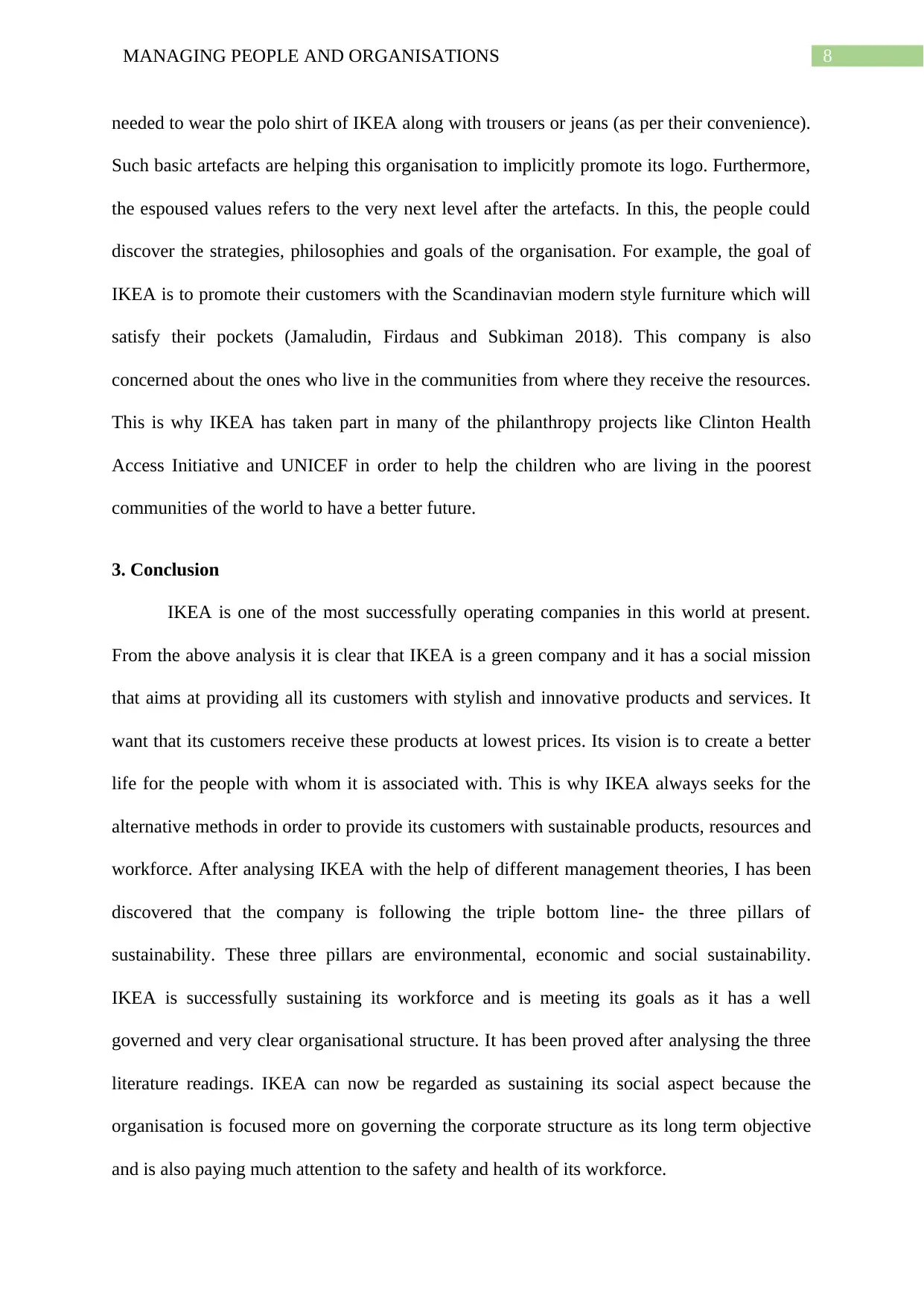
8MANAGING PEOPLE AND ORGANISATIONS
needed to wear the polo shirt of IKEA along with trousers or jeans (as per their convenience).
Such basic artefacts are helping this organisation to implicitly promote its logo. Furthermore,
the espoused values refers to the very next level after the artefacts. In this, the people could
discover the strategies, philosophies and goals of the organisation. For example, the goal of
IKEA is to promote their customers with the Scandinavian modern style furniture which will
satisfy their pockets (Jamaludin, Firdaus and Subkiman 2018). This company is also
concerned about the ones who live in the communities from where they receive the resources.
This is why IKEA has taken part in many of the philanthropy projects like Clinton Health
Access Initiative and UNICEF in order to help the children who are living in the poorest
communities of the world to have a better future.
3. Conclusion
IKEA is one of the most successfully operating companies in this world at present.
From the above analysis it is clear that IKEA is a green company and it has a social mission
that aims at providing all its customers with stylish and innovative products and services. It
want that its customers receive these products at lowest prices. Its vision is to create a better
life for the people with whom it is associated with. This is why IKEA always seeks for the
alternative methods in order to provide its customers with sustainable products, resources and
workforce. After analysing IKEA with the help of different management theories, I has been
discovered that the company is following the triple bottom line- the three pillars of
sustainability. These three pillars are environmental, economic and social sustainability.
IKEA is successfully sustaining its workforce and is meeting its goals as it has a well
governed and very clear organisational structure. It has been proved after analysing the three
literature readings. IKEA can now be regarded as sustaining its social aspect because the
organisation is focused more on governing the corporate structure as its long term objective
and is also paying much attention to the safety and health of its workforce.
needed to wear the polo shirt of IKEA along with trousers or jeans (as per their convenience).
Such basic artefacts are helping this organisation to implicitly promote its logo. Furthermore,
the espoused values refers to the very next level after the artefacts. In this, the people could
discover the strategies, philosophies and goals of the organisation. For example, the goal of
IKEA is to promote their customers with the Scandinavian modern style furniture which will
satisfy their pockets (Jamaludin, Firdaus and Subkiman 2018). This company is also
concerned about the ones who live in the communities from where they receive the resources.
This is why IKEA has taken part in many of the philanthropy projects like Clinton Health
Access Initiative and UNICEF in order to help the children who are living in the poorest
communities of the world to have a better future.
3. Conclusion
IKEA is one of the most successfully operating companies in this world at present.
From the above analysis it is clear that IKEA is a green company and it has a social mission
that aims at providing all its customers with stylish and innovative products and services. It
want that its customers receive these products at lowest prices. Its vision is to create a better
life for the people with whom it is associated with. This is why IKEA always seeks for the
alternative methods in order to provide its customers with sustainable products, resources and
workforce. After analysing IKEA with the help of different management theories, I has been
discovered that the company is following the triple bottom line- the three pillars of
sustainability. These three pillars are environmental, economic and social sustainability.
IKEA is successfully sustaining its workforce and is meeting its goals as it has a well
governed and very clear organisational structure. It has been proved after analysing the three
literature readings. IKEA can now be regarded as sustaining its social aspect because the
organisation is focused more on governing the corporate structure as its long term objective
and is also paying much attention to the safety and health of its workforce.
⊘ This is a preview!⊘
Do you want full access?
Subscribe today to unlock all pages.

Trusted by 1+ million students worldwide

9MANAGING PEOPLE AND ORGANISATIONS
4. References:
Bianchini, M., Arquilla, V. and Krogh, P.G., 2018, July. Service Design in open production,
distribution and organisation as a discipline facilitating democratic critique?.
In ServDes2018. Service Design Proof of Concept, Proceedings of the ServDes. 2018
Conference, 18-20 June, Milano, Italy (No. 150, pp. 654-665). Linköping University
Electronic Press.
Cosmo, D.E. and Yang, K., 2017. A Further Strategic Move to Sustainability-A Case Study
on IKEA. Journal of Strategic Innovation and Sustainability, 12(2), pp.39-47.
Dederichs, A., 2018. Der Kulturbegriff und internationale Zusammenarbeit in Unternehmen.
In Kulturelle Differenzierung in Wirtschaftskooperationen (pp. 11-60).
Freeman, B., Potente, S., Rock, V. and McIver, J., 2015. Social media campaigns that make a
difference: what can public health learn from the corporate sector and other social change
marketers. Public Health Res Pract, 25(2), p.e2521517.
Fruehauf, J., Al-Khalifa, F. and Coniker, J., 2015. USING THE BOLMAN AND DEAL'S
FOUR FRAMES IN DEVELOPING A DATA GOVERNANCE STRATEGY. Issues in
Information Systems, 16(2).
Garvey, P., 2017. Consuming IKEA and Inspiration as Material Form. Design Anthropology:
Object Cultures in Transition, p.101.
4. References:
Bianchini, M., Arquilla, V. and Krogh, P.G., 2018, July. Service Design in open production,
distribution and organisation as a discipline facilitating democratic critique?.
In ServDes2018. Service Design Proof of Concept, Proceedings of the ServDes. 2018
Conference, 18-20 June, Milano, Italy (No. 150, pp. 654-665). Linköping University
Electronic Press.
Cosmo, D.E. and Yang, K., 2017. A Further Strategic Move to Sustainability-A Case Study
on IKEA. Journal of Strategic Innovation and Sustainability, 12(2), pp.39-47.
Dederichs, A., 2018. Der Kulturbegriff und internationale Zusammenarbeit in Unternehmen.
In Kulturelle Differenzierung in Wirtschaftskooperationen (pp. 11-60).
Freeman, B., Potente, S., Rock, V. and McIver, J., 2015. Social media campaigns that make a
difference: what can public health learn from the corporate sector and other social change
marketers. Public Health Res Pract, 25(2), p.e2521517.
Fruehauf, J., Al-Khalifa, F. and Coniker, J., 2015. USING THE BOLMAN AND DEAL'S
FOUR FRAMES IN DEVELOPING A DATA GOVERNANCE STRATEGY. Issues in
Information Systems, 16(2).
Garvey, P., 2017. Consuming IKEA and Inspiration as Material Form. Design Anthropology:
Object Cultures in Transition, p.101.
Paraphrase This Document
Need a fresh take? Get an instant paraphrase of this document with our AI Paraphraser

10MANAGING PEOPLE AND ORGANISATIONS
Hahn, Y. and Kim, D., 2016. Corporate Social Responsibility: A Comparison Analysis. The
East Asian Journal of Business Management, 6(4), pp.13-17.
Higa, H., 2015. The Power of Soccer: A Promising Tool for Youth Empowerment A Case of
Soccer-Based Health Program at El Nacional Public School in Ecuador.
Jamaludin, M., Firdaus, B.A.T. and Subkiman, A., 2018. The Influence of Scandinavian
Furniture Design in the Development of Modern Rattan Furniture in Indonesia. Journal of
Arts and Humanities, 7(3), pp.19-26.
Maidment, A., 2015. How big brands are using renewable energy to their
advantage. Renewable Energy Focus, 16(4), pp.84-86.
Morsing, M. and Roepstorff, A., 2015. CSR as corporate political activity: Observations on
IKEA’s CSR identity–image dynamics. Journal of Business Ethics, 128(2), pp.395-409.
Schein, E., 2015. Taking Culture Seriously in Organization Development. Practicing
Organization Development: Leading Transformation and Change, pp.233-244.
Skelcher, C. and Smith, S.R., 2015. Theorizing hybridity: Institutional logics, complex
organizations, and actor identities: The case of nonprofits. Public administration, 93(2),
pp.433-448.
Vahlne, J.E. and Jonsson, A., 2017. Ambidexterity as a dynamic capability in the
globalization of the multinational business enterprise (MBE): Case studies of AB Volvo and
IKEA. International Business Review, 26(1), pp.57-70.
Vikkelsø, S., 2015. Core task and organizational reality. Journal of Cultural Economy, 8(4),
pp.418-438.
Hahn, Y. and Kim, D., 2016. Corporate Social Responsibility: A Comparison Analysis. The
East Asian Journal of Business Management, 6(4), pp.13-17.
Higa, H., 2015. The Power of Soccer: A Promising Tool for Youth Empowerment A Case of
Soccer-Based Health Program at El Nacional Public School in Ecuador.
Jamaludin, M., Firdaus, B.A.T. and Subkiman, A., 2018. The Influence of Scandinavian
Furniture Design in the Development of Modern Rattan Furniture in Indonesia. Journal of
Arts and Humanities, 7(3), pp.19-26.
Maidment, A., 2015. How big brands are using renewable energy to their
advantage. Renewable Energy Focus, 16(4), pp.84-86.
Morsing, M. and Roepstorff, A., 2015. CSR as corporate political activity: Observations on
IKEA’s CSR identity–image dynamics. Journal of Business Ethics, 128(2), pp.395-409.
Schein, E., 2015. Taking Culture Seriously in Organization Development. Practicing
Organization Development: Leading Transformation and Change, pp.233-244.
Skelcher, C. and Smith, S.R., 2015. Theorizing hybridity: Institutional logics, complex
organizations, and actor identities: The case of nonprofits. Public administration, 93(2),
pp.433-448.
Vahlne, J.E. and Jonsson, A., 2017. Ambidexterity as a dynamic capability in the
globalization of the multinational business enterprise (MBE): Case studies of AB Volvo and
IKEA. International Business Review, 26(1), pp.57-70.
Vikkelsø, S., 2015. Core task and organizational reality. Journal of Cultural Economy, 8(4),
pp.418-438.
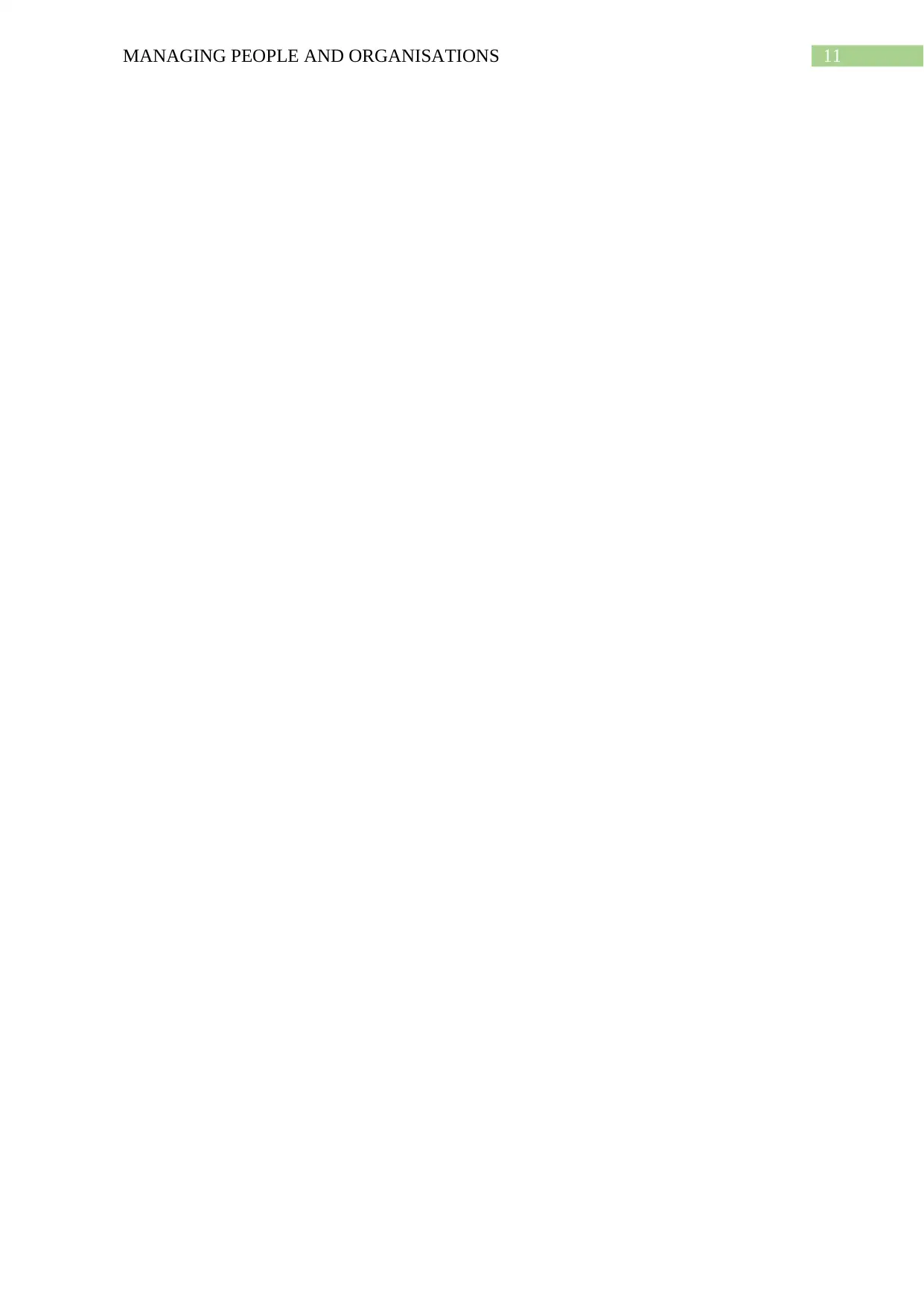
11MANAGING PEOPLE AND ORGANISATIONS
⊘ This is a preview!⊘
Do you want full access?
Subscribe today to unlock all pages.

Trusted by 1+ million students worldwide
1 out of 12
Related Documents
Your All-in-One AI-Powered Toolkit for Academic Success.
+13062052269
info@desklib.com
Available 24*7 on WhatsApp / Email
![[object Object]](/_next/static/media/star-bottom.7253800d.svg)
Unlock your academic potential
Copyright © 2020–2025 A2Z Services. All Rights Reserved. Developed and managed by ZUCOL.




